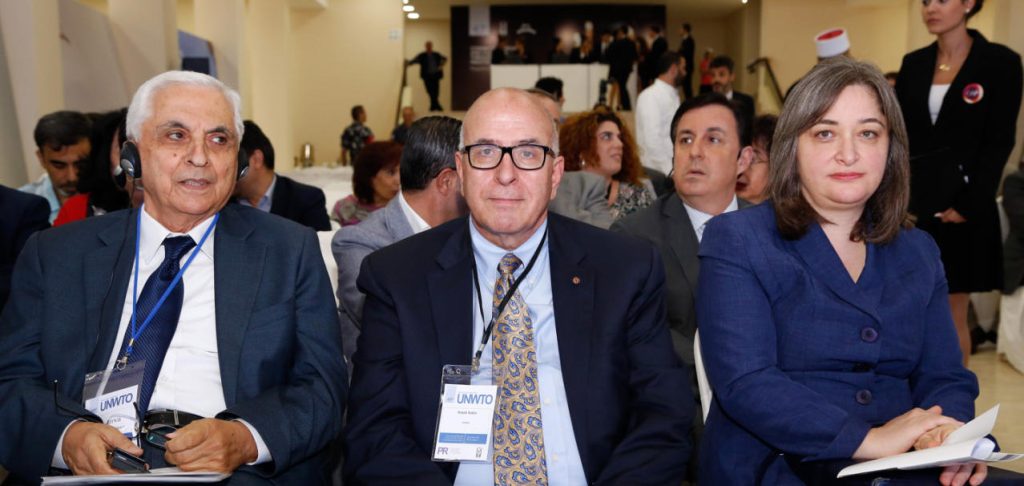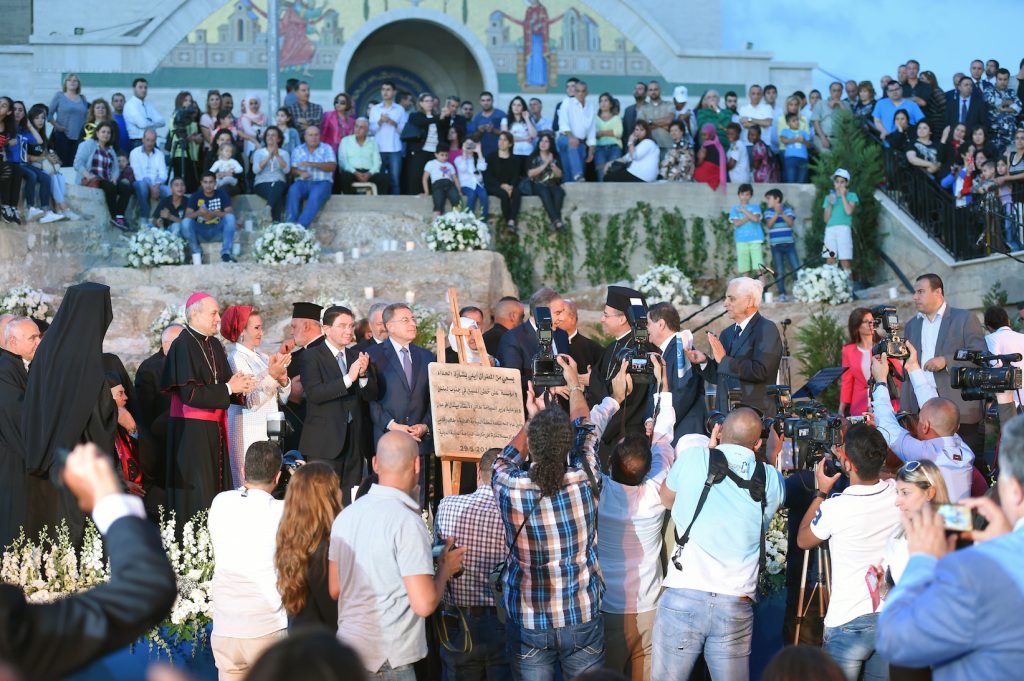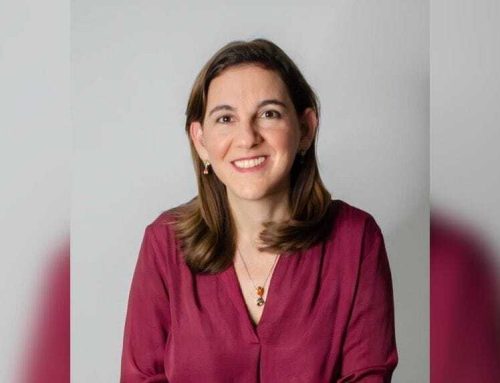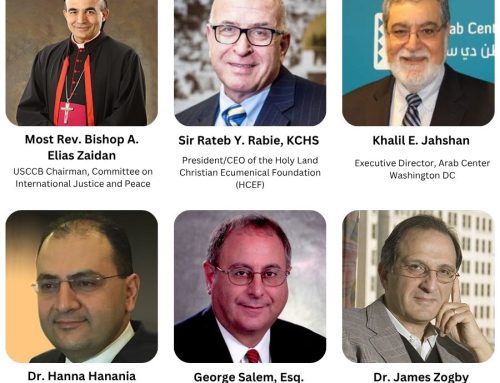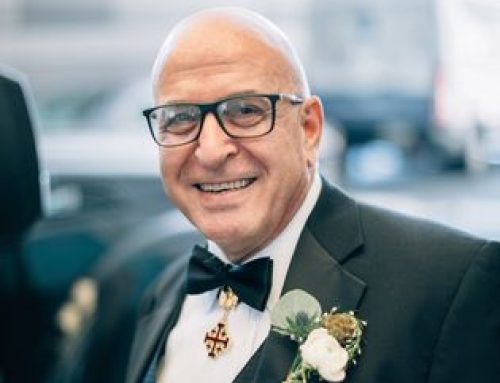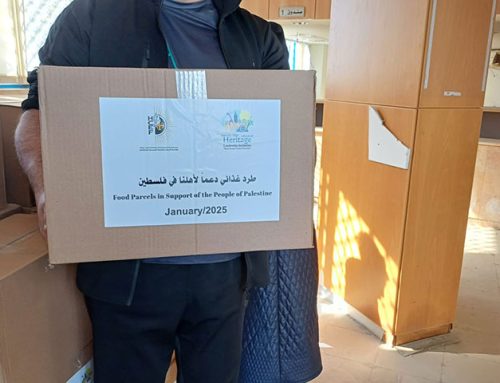
Ministers of Tourism of the Levant joined by religious tourism experts gathered to discuss challenges and suggestions for supporting religious tourism. From Left to Right: Michel Pharaon, Minister of Tourism of Lebanon; Nayef Al Fayez, Minister of Tourism and Antiquities of Jordan; Rula Ma’ayah, Minister of Tourism and Antiquities of Palestine; Mohammad Abdel Jabber Musa, Chairman of the Iraqi Tourism Board; Amr El Ezabi, Advisor to the Minister of Tourism of Egypt; Francisco Singul, Director of Culture for Saint James way, Galician Tourism Board, Spain; Sir Rateb Rabie, KCHS, President and CEO of the Holy Land Christian Ecumenical Foundation, Inc.; Dina Tadros, Managing Director and Partner, ITALôTEL Tours, Egypt; Samir Sarkis, Founding Member and General Secretary of On the Footsteps of Jesus, South Lebanon Foundation.
Beirut, Lebanon – The United Nations World Tourism Organization (UNWTO) and the Lebanon Ministry of Tourism invited Sir Rateb Rabie, KCHS, President and CEO of the Holy Land Christian Ecumenical Foundation (HCEF), to speak at a roundtable discussion on religious tourism this past weekend. The two-day conference entitled “Connecting people and cultures through Tourism in the Mediterranean Region,” took place on Sunday, May 29th through Monday, May 30th, 2016 in conjunction with the launching of “Our Lady of Mantara – Maghdouche” as an international religious tourism destination in Beirut, Lebanon.
Sir Rateb was invited to participate as a member of the Palestinian delegation due to HCEF’s 18 years of experience developing the bonds of solidarity between Arab Christians of the Holy Land and Christians worldwide through culture and pilgrimage. Through its Holy Land Tours, particularly the Living Stones Pilgrimages, the HCEF has used cultural and religious tourism to educate the West about the Holy Land and its peoples, specifically the Arab Christians who were amongst the first followers of Christ. Fostering these people-to-people interactions is what cultural tourism is all about. Yet HCEF takes it one step further, by focusing on pilgrimages and fostering pilgrim engagement with the region after their return.
The roundtable discussion was preceded by an opening session, in which Michel Pharaon, the Minister of Tourism of Lebanon, and Dr. Taleb Rifai, the Secretary-General of the UNWTO, shared opening remarks.
The roundtable on religious tourism explored the challenges and opportunities for the development of religious tourism routes in the Levant, cross-country pilgrimages, and networks of religious tourism destinations, as effective means to foster regional development and integration, cross-cultural exchanges and understanding as well as self-education and learning. Participants of the Roundtable Discussion pose for a photograph alongside conference participants. Speakers at the roundtable discussion, held at the Maghdouche Basilica in the Sidon region, included: Sir Rateb Rabie, KCHS, Founding Member, President and CEO of HCEF; Michel Pharaon, Minister of Tourism of Lebanon; Nayef Al Fayez, Minister of Tourism and Antiquities of Jordan; Rula Ma’ayah, Minister of Tourism and Antiquities of Palestine; Mohammad Abdel Jabber Musa, Chairman of the Iraqi Tourism Board; Amr El Ezabi, Advisor to the Minister of Tourism of Egypt; Francisco Singul, Director of Culture for Saint James way, Galician Tourism Board, Spain; Dina Tadros, Managing Director and Partner, ITALôTEL Tours, Egypt; Samir Sarkis, Founding Member and General Secretary of On the Footsteps of Jesus, South Lebanon Foundation. Her Excellency Rula Ma’ayah, Minister of Tourism and Antiquities of Palestine, began the discussion explaining the challenges and obstacles to tourism in the Holy Land. She identified these as the ongoing occupation and political unrest that make it difficult to plan for the long term and to develop the tourism industry. She concluded by stating that despite these obstacles and challenges, the tourism industry continues to grow in Palestine and has great potential to bring prosperity to the country and to its population. From Left to Right: Mr. Samir Sarkis, Sir Rateb Rabie, and H.E. Rula Ma’ayah. In his remarks, Sir Rateb explained that when it comes to tourism in the Holy Land, religion plays a large role due to the fact that visiting the holy sites is one of the major draws of visiting Palestine. He stressed that pilgrimages differ from religious tourism in that they are undertaken as a journey to encounter the divine; they are a genuine exercise in prayer, and as such require a different approach. He also stressed the important role pilgrimages play in advocating and promoting peace in the Holy Land. Sir Rateb proposed an integrated approach with connects all of the key players: pilgrims, local churches, travel agencies, and the governments of the destination countries, for a more synchronized approach to promoting tourism to Palestine. Sir Rateb stressed the importance of connecting the local churches in the countries of the pilgrims with the local churches in the Holy Land. To put it in economic terms, local churches in the pilgrims’ home country best know the “customer” and would be able to advise travel agencies as to how to market to them, while the local churches in the Holy Land best know the “product” being “sold”- the Holy Land and its people. A third party would cooperation and communication between all five above-mentioned entities. This third party would also follow-up with pilgrims once they return home to help them turn their experience and passion into action by facilitating twinning relationships and building upon the people-to-people interactions pilgrims had with the indigenous Christian community of Palestine. Sir Rateb also recommended greater cooperation across the Levant in developing inter-country tourism packages. After all, the Holy Land extends past the geographical region where Jesus Christ carried out his ministry. It extends to all the places the Holy Family walked and visited. Thus the countries across the Levant boast a plethora of holy sites, many of which go unnoticed by potential visitors. Sir Rateb expressed that greater coordination between these countries to package the sites as one would rectify this problem. Crowds gather to commemorate the official recognition of “Our Lady of Mantara- Maghdouche” as an international religious tourism destination. The roundtable discussion and debate was followed by launching “Our Lady of Mantara – Maghdouche” as an international religious tourism destination. Our Lady of Mantara, or Our Lady of Awaiting, is the name of a shrine dedicated to the Virgin Mary. The shrine is built on the site where she rested and waited for her son Jesus Christ to finish preaching in Sidon. The shrine is under the care of the Melkite Greek Catholic Church. Nour Farra-Haddad, Ph.D., of NEOS Tourism Consulting, led conference participants on a familiarization tour of Lebanon’s beautiful religious sites. From Left to Right: Jiří Boháč, Purchasing & Product Development manager at Q Events & Destination Management s.r.o.; Barbara Chiodi, Executive Director of Brevivet; Ma Dolores López Sánchez, Pilgrimage Department of ICSCO Foundation; Nour Farra-Haddad; Renee Hattar, Pilgrimage Department of ICSCO Foundation; Sir Rateb Rabie, KCHS; and Francisco Singul. The following day, the Working Group on the Phoenicians’ Route Cultural Tourism Program met for the second time, this time they met at Le Pavillon Royal, BIEL, Beirut. Their meeting considered a proposed roadmap and action plan for the development and promotion of a Cultural Tourism Programme along the Phoenicians’ Route, as well as the type of partnerships required for their implementation. The two-day conference concluded with a closing ceremony in which Michel Pharaon and Dr. Taleb Rifai shared closing remarks. [i] Roundtable on Religious Tourism. UNWTO, Beirut, Lebanon. 29 May 2016.
